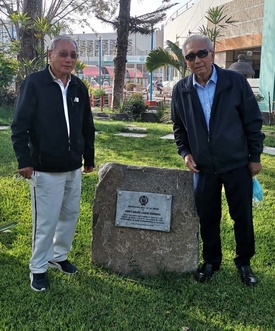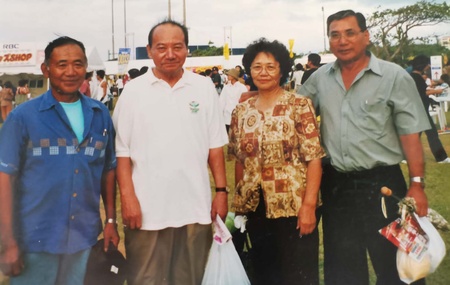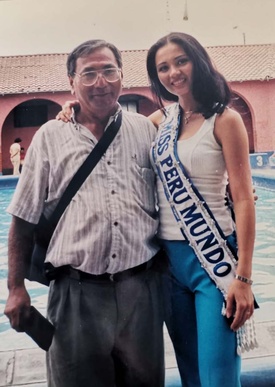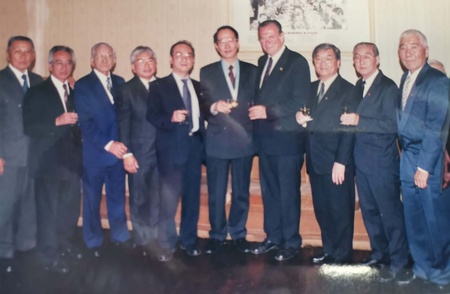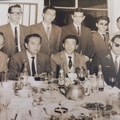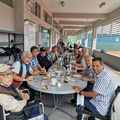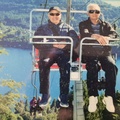There are friendships that, when talking, one tends to see in them a kind of “Human Encyclopedia.” And the curious thing was that the Coronavirus in its long history taught us the sudden change that we had to make in our lives. I, in particular, experienced that, being “El Rincón de los Pájaros Muertos”, the place that I visited most frequently was the AELU, due to its proximity to the entrance door on La Mar Avenue. It was the center of my new friendships. And there, between cups of coffee, chocolate or orange juice, afternoon after afternoon, we new friends got to know each other.
Alberto Izu Izu, 'Rabito', as all his friends at AELU know him, was tempted to see him arrive and meet him in person, who turned 85 on April 16. I was surprised in our first conversation that the sporting history of the AELU has in its person a worthy representative, as if this were it. 'Rabito' is the “Sports Encyclopedia” for all the knowledge that one learns when talking to him.
In the next meeting we had, the conversation extended purely to our childhood, youth and passed through the years that we had to dedicate ourselves to work. And I say “we had” because of the parallel proximities of our life stories.
See the light of existence in the Upper Neighborhoods of Lima and study his few years at the Jardín Gakuen Japanese School until the fourth year of primary school, and then dedicate himself to work having the wonder of being a “palomilla” boy who immerses himself in the sport, especially in athletics, his favorite being sprint races. 'Rabito' began his sporting life at the Mayorista Club, participating in the Undokai in 1954 and 1955. In 1956, he defended the colors of Santa Beatriz and, the following year, he returned to the Mayorista Club. In 1958, he moved to the Motobu Club and there he finished his athletics career.
Alberto Izu Izu carries the flow of his sporting life in his veins. Parallel to athletics, his other passion is football, which he dominates and, in the beginning, he was in the Club del Mercado Mayorista, back in 1953, the year in which the La Unión Stadium, AELU, was born, and he ended up keeping his chimpunes in the sixties, playing for Club Sakura.
Today, to see him in a sports uniform is to foreshadow that the years do not pass for him, and above all through the mind, which can be seen in the play on words that he welcomes at every moment and conveys to us with a memory. This Sunday that passed I experienced it firsthand. “The Walkers” of AELU and APJ were guided by their words, their comments and the exercises we had to do before starting the walk on the Beach Circuit and finishing it on the historic and beautiful Playa La Herradura.
“A cry for help” is the title of an article in the newspaper La Industria , from the city of Trujillo, dated “Wednesday, May 26, 1999.” During those years, Alberto Izu Izu worked in the city of eternal spring and, as his name was known in national sports, he was named "President of the Reorganizing Commission of the Athletics League of the city of Trujillo." Alberto Izu had ambitious plans, but he needed a leader to lead grassroots sports. Is an athlete born or made?
In his words, “the athlete is born, the physical conditions and talent are innate. The technician, according to his abilities, prepares him for certain tests. It evaluates the athlete's biotype and prepares them for track tests (speed, middle distance and long distance) and field tests (throwing, jumping, etc.). Physical conditions are important. For example, a jumper must be tall, lanky (long lower and upper limbs). A sprinter must have a lot of power, strength. That is why the best Olympic throwers are also good at 100 meters and must have good muscle volume.”
Alberto Izu's knowledge of Nikkei sports events
Since when have undokai been performed in Peru?
“Before 1945, the issei organized them at the Lima Nikko School, after 1945 each Nikkei school organized its own undokai, inviting different institutions to participate. In 1948, when I was studying at the Jardín Gakuen School, I participated in the undokai of the Minato Gakuen and the José Gálvez School, competing in relays.”
“In 1955, José Watanabe held the title of the classic Cien Metros Planos. In 1956, I managed to become champion in the classic 100 meter dash until 1960, the year in which Juan Hasegawa appeared. In 1979 I was champion in my 100 meter dash category in Argentina at the age of 42.
Baseball was another of my favorite sports and I played for the Kyuyu Club in the sixties. I became a referee and I did it once in Japan. Men's volleyball was another of my favorite sports and I played for the Club Mariscal Castilla de La Victoria, in the eighties. Another of my sports was Bocce at the La Victoria Casino in 1981.
In summary, my sporting life was athletics, soccer, baseball, volleyball and bocce. Today, my new concern is once again athletics. With the 'senior athletes', the AELU and APJ walkers."
Feeling that age has no meaning in sport is one of the principles that I notice in Alberto Izu's life. The spirit in its daily bustle invites me to participate in my modest walk and turn that restlessness into the generous awakening of a life that, little by little, is extending us to ninety years. Talking and having him for company makes me feel that life is a kind of distinguished race towards a goal where I always see the excitement of arrival.
They always told us that in football the goalkeeper was the position that no one wanted. Kicking on the run and running after the ball was the watchword of anyone who was good with the ball. To be honest, I guarded the bow because I was bad with my feet, I only used my hands and having the bow for myself.
Alberto 'Rabito' Izu also had the proof of guarding the goal when it came to playing football. In his case it was because of the shoes. His father punished him every time he saw him kick the ball and 'Rabito' got used to leaving his shoes and using them as a goal to play with. I was nine years old and it was the time of World War II, when the economic crisis broke out in full force.
Today, thinking back to the 1940s, when our childhood came out of nowhere, makes my mind feel like they were the best years of our lives. Not having any toys was a foreign feeling. The street was the passion of our life, there we spent the day playing simple games that delighted us to the point of exhaustion. The lingo, the game of the world, the stick, the Chinese stick, the run run, the spinning top, the game with the movies and, above all, the tranquility of the tracks and paths. Friends' houses were like our houses and the water we drank was the feeling of a mother who always extended her hand to us.
Today, in the shelter of AELU, with our generation tending to reach ninety years old, the memories of our childhood become stories of sentimental passages in the voices of Alberto Izu, Justo Kanashiro, Augusto Yamashita, 'Kachin', Jorge Aoki , 'Mabo', Eduardo Oka and many more friends whom I consider as such: encyclopedias of memory.
© 2022 Luis Izu Izu


